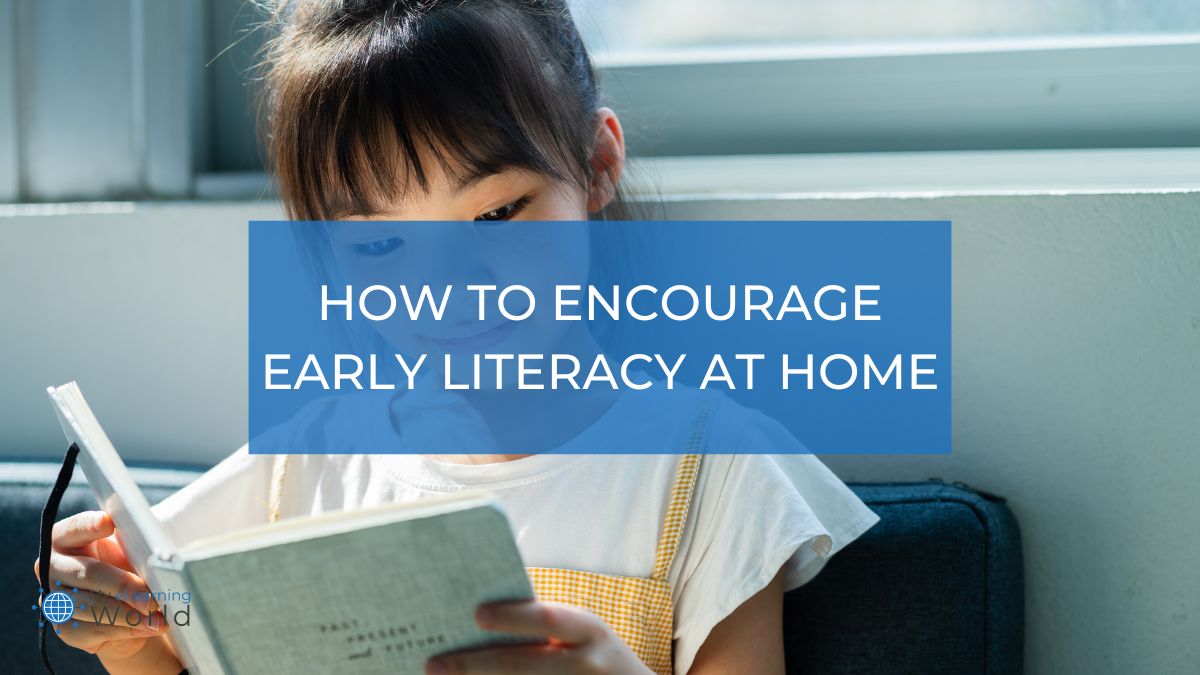Strong literacy skills are the foundation of learning. From language arts to history, science, and more, your child’s reading abilities pave the way for countless educational discoveries.
Reading also fosters imagination, curiosity, and creativity. It broadens your child’s understanding of the world and expands their capacity for empathy and compassion.
Simply put, a love of reading is one of the best gifts we can give our children. Nurturing your child’s early literacy development is one of the best ways to start on the right track with reading.
As a teacher, I’ve outlined 5 simple strategies I believe to be highly effective to encourage a love of reading at home, even before your child embarks on their first day of school.
Strategy #1: Read and Rhyme Out Loud
Let’s start out with the obvious: spend time reading with your child!
Your little one can enjoy reading books with you long before they’re even able to talk.
Listening to you read a story is both comforting and entertaining for them, and helps build an early understanding of print.
For example, a child who’s been read to since infancy will be quicker to understand that books have title pages and illustrations, and that pages are read in order from left to right.
They’ll know from experience that the letters on the page form words, and that words form sounds with meaning.
These concepts may seem basic, but they’re essential to a strong literacy foundation.
Rhyming books are especially good for little ones, as the singsong cadence of the words is easier to recognize and remember.
This improves your child’s phonological awareness, or understanding of sounds and words.
And even though you may feel like you have the words to Llama Llama Red Pajama tattooed on your brain, repetition is good for phonological awareness too!
Hearing the same beloved story over and over improves your child’s recall and memory, and deepens their understanding of what happens in the book.
The sooner you build a habit of reading out loud with your child, the sooner they will understand words and phrases… and the sooner they will associate books with a pleasant learning experience.
Strategy #2: Make Connections Between Stories and Life
Spending time reading is key, but so is talking about what you’ve read with your child.
For very young children, you can point out familiar objects in illustrations, or note how the characters in the story do the same things as your child. (“Look, that baby is having a bottle like you!”)
When your child gets a bit older, you can make more sophisticated connections to their daily lives.
If there’s a conflict in the story, for example, ask your child to think of a time they faced a similar problem. (“Have you ever had a toy you didn’t want to share?”)
If a character feels a strong emotion, think back to a time you or your child might have experienced that same feeling. (“What’s a time you felt excited as the bunny in the story?”)
Connecting what happens in stories to what happens in our lives is a huge part of literacy.
This connection establishes that books – whether fiction or nonfiction, silly or serious – enrich our understanding of our world and ourselves.
When kids see the value of stories and relate to them personally, they’re much more likely to be invested in reading… even when it feels challenging.
Strategy #3: Engage with Educational Apps
 HOMER - The Essential Early Learning Program and App for Kids 2-8
HOMER - The Essential Early Learning Program and App for Kids 2-8
HOMER is a personalized learning app designed to help kids fall in love with learning. There are over 1,000 learning activities across all subjects, and the content is tailored to your child's age and interests.
Screen time can be a thorny issue for parents.
Little ones are mesmerized by screens, but as parents we’re aware of the damage they can cause to our children’s imaginations and attention spans.
The most important thing to understand is that not all screen time is created equally.
Allowing your child to spend an appropriate amount of time using quality educational apps can actually help improve their literacy skills and boost their engagement with reading.
Just make sure that the app you’re using isn’t a gimmick. Look for expert backing, positive reviews, and a focus on actual literacy understanding (instead of mindless games or rote memorization).
Oh, and if the app is blinking with a million pop-up ads, it’s probably wise to pass it up.
We recommend an app like HOMER, a research-backed early reading program specifically designed to teach literacy to young children in an entertaining way.
HOMER is personalized to your child’s age, skill level, and interests, so every lesson they complete is tailored to exactly what they need.
HOMER builds word recognition, comprehension, and fluency skills, and there are built-in games and milestones to boost your child’s motivation and focus.
The app includes books across a huge variety of subjects, making it possible for your child to read texts that appeal to them on an individual level.
As an added bonus for parents, HOMER is ad-free and easy for your child to navigate, so you can let them enjoy the app independently without worrying for their online safety.
You can take the HOMER app for a spin with a 60-day free trial to see all it has to offer as part of your reading routine.
Strategy #4: Encourage Writing and Drawing
Literacy isn’t only about listening to stories… it’s also about creating them!
Encouraging your child to write and draw from a young age is a great way to foster a love of storytelling and creativity.
Ask your child to draw a picture of what they did in day care, or let them dictate a nonsense story to you.
Encourage them to “write” even if all they’re doing is scribbling across the page.
You can even get creative and let your child write and draw with sand, clay, or a stick in the dirt.
After all, the more they learn that they can express their ideas with words and pictures, the better!
Don’t forget to have your child explain their masterpiece to you when they’re done.
Letting them tell you about their drawing or writing builds your child’s ability to tell a story with a beginning, middle, and end.
Sharing their creations also strengthens the idea that words carry meaning… and that they have something valuable to share.
Those early crayon drawings and shakily penciled letters have major sentimental value, but they’re also a valuable building block of early literacy!
Strategy #5: Build a Routine
The key to making all of these strategies as effective as possible is to stick to a literacy routine.
Life with kids is hectic, and it can be hard to map out exactly what any one day will bring.
That said, the more effort you put into establishing a consistent routine, the more your literacy strategies will pay off.
Young children find consistency comforting. When they know what to expect and when, they’re more likely to actually focus on what they’re doing (instead of wondering what’s going on).
Even if your daily schedule is subject to change, you can still develop a reading routine that works for you.
Naptime and bedtime may not be at the exact same moment each day, for example, but you can still make it a habit to read aloud for ten or fifteen minutes before your little one goes to sleep.
Errands and activities may vary, but you can carve out time for literacy even when you’re on the go.
You can make connections to texts and stories you’ve read even in casual conversations, and point out written words on signs and billboards when you’re doing errands.
Kids can engage with apps like HOMER in the car, or draw a picture or story while waiting at an older sibling’s sports practice or appointment.
Carving time out for literacy every day establishes how important reading is for your child.
When your child reads, listens, writes, draws, and shares every day, they won’t see reading as a chore to be crossed off the list… they’ll see it as an integral part of daily life.
Final Thoughts
Taking the time to build your child’s literacy foundation may feel like a lot of effort, but the payoff is worth it.
The strategies I shared in this article can maximize your child’s literacy success and make it easier for them to understand more complex concepts later on.
These strategies will also help you frame reading, writing, and drawing as joyful and rewarding activities.
This sets the stage for your child to actually enjoy their education instead of viewing it as an unpleasant necessity.
After all, there’s nothing more valuable than a lifelong love of learning.
Do you have or teach young children who are developing their early literacy skills? Have any suggestions we didn’t mention here? We’d love to hear your ideas and questions in the comments below!


